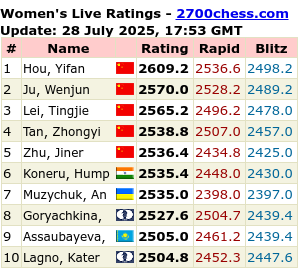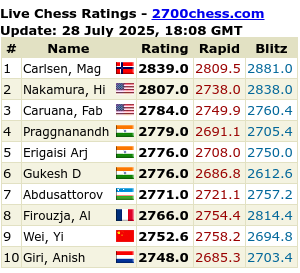2 May 2010 – At the susanpolgar’s website, she does an excellent running commentary of each move of the World Chess Championship between GM Anand and GM Topalov. She would write what moves would be best from her perspective for each player and the probable thinking behind each player’s move. Here is one of her running commentaries for game 6 played last night, 1st May 2010 where the game ended in a draw.
(courtesy of susanpolgar.blogspot.com)
1. d4 Nf6 2. c4 e6 3. Nf3 d5 4. g3 dxc4 5. Bg2 a6 Deja vu all over again! We have another Catalan.
6. Ne5 c5 7. Na3 cxd4 8. Naxc4 Bc5 9. O-O O-O 10. Bg5 In game 2, Anand played with the less aggressive 10. Bd2. Topalov did have a decent position until 25....Ne3.
10...h6 11. Bxf6 Qxf6 12. Nd3 Anand is down a pawn. However, he has plenty of compensation. Topalov has problem developing pieces on the Queenside because of the b7 pawn. 12..Ba7 makes the most sense here.
GM Harikrishna of India just sent me the following note: "Age is not very significant. As far as I observed the match Anand-Topalov, I feel that Anand has understood the weakness of Topalov. Unless Topalov changes something like opening, strategy, etc., Anand will win this match convincingly."
12...Ba7

13. Qa4 The idea of this move is to prevent Nc6. Anand must maintain his initiatives. He cannot allow Topalov to get his pieces out freely because he is a pawn down and his opponent has a Bishop pair. Topalov must be very patient to get one piece out at a time.
13...Nc6 Topalov gets his Knight out anyway. He is offering to give the pawn back. However, Anand will have problems if he takes as it will open the h1 - a8 diagonal for Topalov.
14. Rac1 Anand is wisely not taking the Knight. The general rule of thumb is if your opponent has a cramp position, don't help by exchanging pieces to open up the position. I was just asked the following question. Why would Topalov repeat the same opening if he lost with it before? Good question. Many players are stubborn. In this case, Topalov isn't convinced that he lost game 2 because of the opening. He lost because of a bad 25th move Ne3. One problem for Topalov so far is Anand seems to deviate first too often in this match. This has to change if Topalov wants to win this match.
14...e5 Topalov once again is offering the pawn back.
15. Bxc6 b5 16. Qc2 Qxc6 17. Ncxe5 This position is quite interesting. 2 Knights versus 2 Bishops. White still has excellent space advantage and the 7th rank may give Anand some play. Topalov will try to avoid trading Queens to maximize the power of his Bishops. Therefore, 17...Qe4 makes sense. On the other hand, Anand would want to exchange Queens so I can see 18. Qc6 if Topalov does indeed play Qe4
I would love to be able to read Topalov's mind here. Is he trying to go all out to win regardless if he is White or Black? Or is he just content to hold as Black after 2 losses then go for it with White? The second logic is more in line with most matches. However, Topalov has a completely different mindset than most top players. He is not afraid to take chances and he is definitely not afraid to lose. Just as my sister Judit said about Topalov, this is a very rare quality.
17...Qe4 18. Qc6 Bb7 19. Qxe4 Bxe4 As expected, Queens are now off the board. I think for the first time in this match, Topalov can comfortably draw with Black.
20. Rc2 The idea of this quiet move is to double up the Rooks on the c file. This will be another good endgame lesson for the fans, Bishops vs. Knights. One thing I do not understand is many people like to criticize Kramnik for drawing too often and coasting as Black. But then these same people are not happy that Topalov is trying to win in every game, even in "drawish" positions. What gives?
20...Rfe8 Anand can double up his Rooks. However, Topalov can now play Bb6 defending the c7 square without worrying about the Nd7 fork.
21. Rfc1 f6 Disconnecting the Knights and putting potential pressure on White's e2 pawn. Topalov must be happy with his position here. This is a comfortable position for him which is rare with Black so far in this match. If. 22. Nc6 then Bb6 to preserve his Bishop pair.
22. Nd7 An interesting choice. Anand can now reconnect his Knights with N7c5 22...Re7 or Bf5.
22...Bf5 23. N7c5 Anand must be physically and mentally fit to play a match against Topalov. In most World Championship matches, from time to time there would be short draws so players can recoup. But against Topalov, every game is going to the distance. There will be no short draw. Therefore, Anand has to be prepared to have a long game every game.
23...Bb6 Anand's Knights can be annoying. He has the option of Nb7 then Nd6.
24. Nb7 I think Topalov has to play Bg4 here for 2 reasons: 1. Avoid the Nd6 fork and 2. Put pressure on the e2 pawn.
24...Bd7 I did not expect this move. It's is un-Topalov-like :) With this move, Topalov basically blocked the effectiveness of Anand's Rooks on the c file. I still like Bg4 better.
25. Nf4 This is an interesting choice by Anand. Now Topalov can play Rac8 to trade off the Rooks. This is a possible continuation: 25... Rac826. Nd5 Rxc2 27. Rxc2 Bh3. White cannot take the Bishop on b6 because of d3 0-1. Here is another possible line: 25...Rac8 26. Nd5 d3 27. exd3 Rxc2 28. Rxc2 Bh3 29. Ne3 =
25...Rab8 Anand has the option of playing 26. Nd6 or 26. Nc5. I prefer 26. Nd6 a little more although it does depend on Anand's mindset. Is he trying to win or is he happy with a draw with White to maintain a 1 point lead? Nd6 will keep things more complicated while Nc5 may result in piece exchanges.
26. Nd6 Re5 The position is still even.
27. Nc8 Anand is toying with Topalov. As I mentioned above, Anand's Knights can be very annoying. They are driving Topalov crazy. Topalov's pieces are still not coordinated yet. Eventually, I believe Topalov will be frustrated and will exchange off one of the Knights to regain his sanity.
One other thing to keep in mind is when chess fans watch the games at home, they are doing so at their own leisure with no pressure whatsoever. However, when you are in the world chess championship, the pressure alone will force you to double, triple, and quadruple check everything because one bad move can cost a player the match.
This is like a field goal kicker with a 40 yard kick to give his team the Super Bowl victory, or a basketball player on the free throw line in the 7th game game of the NBA championship with 0.3 second left. Your team is down by 1 and you must make both free throws for your team to win. Does anyone remember Bill Buckner of the Red Sox in game 6 of the 1986 World Series against the Mets? One botch play haunted him for the rest of his life. It is easy to criticize Topalov or Anand when nothing is on the line.
27. Ba5 28. Nd3 Anand is toying with Topalov with his Knight moves.
28...Re8 Anand only has one option here which is to bring his Knight to d6.
29. Na7 I am not so sure that this is the best move for Anand. 29...Ra8 30. Nc6 Bxc6 31. Rxc6 Rxe2and Black is fine.
29...Bb6 30. Nc6 Now 30... Bxc6 31. Rxc6 Rxe2 = Black is up a pawn but White has more than enough compensation. I do not see either side winning in this line.
30...Rb7 31. Ncb4 a5 32. Nd5 Topalov has gone out of his way to avoid exchanging one of his Bishops. It is hard to imagine that he can continue to do that without having to play inferior moves. 32...Bf5 is a good move here but it means that Topalov has to give up at least one of his Bishops.
32...a4 I did not expect this move. Topalov is finally willing to let go of one of his Bishops. If 33. Nxb6 Rxb6 34. Rc7 Be6 35. Ra7 Bxa2 36. Rcc7 g5= Black is up a pawn but White has his Rooks on the 7th rank.
33. Nxb6 Rxb6 The question is will Anand go for the forced draw line I mentioned above?
34. Nc5 No, he chose a different continuation. Black is fine in this position. 1/2 of the Knightmare is over :) Topalov can breathe a little easier now.
34...Bf5 35. Rd2 Black can simply play Rc6. White cannot take the d4 pawn because of Rec8 winning the Knight.
35...Rc6 36. b4 axb4 37. axb3 I think Topalov must play b4 here. He cannot allow White to play b4. 37...b4 38. Rxd4 Rec8 39. Rdc4 Bg6 40. Nd3 Rxc4 41. bxc4 b3 42. Rb1 Rxc4 43. Rxb3 Rc2 44. Kf1 Bf5 45. f3 +=. Here is another line 38. Rxd4 Rxe2 instead of Rec8 39. Rxb4 Rd6 +=
37...b4 38. Rxd4 Rxe2 39. Rxb4 Bh3 40. Rc4 Rd6 += Black should be able to hold this in spite of being a pawn down. He has enough compensation with his piece placement. 41. Re4 Rc2 42. Ree1 Rb2 43. Rcd1+=
41. Re4 Rb2 42. Ree1 = I do not think either player can win here. This should be a draw. If Rdd2 then Ne4 =
42...Rdd2 43. Ne4 We can have another repetition here with 43... Rd4 44. Nc5 Rdd2 45. Ne4 =
43...Rd4 Even though this move is fine, I think 43...Rd3 is a little better.
44. Nc5 Topalov has to bring his d Rook back to d2. But after Anand plays Ne4, I think he should try Rd3 since he can't lose in this position.
44...Rdd2 45. Ne4 Rd3 As I mentioned above, Topalov can't lose so why not? Now he gets the pawn back with a slightly better position. It is still a draw but he has nothing to lose by trying.
46. Rb1 Rdxb3 47. Nd2 = Rb4 This is probably payback time. Anand was toying with Topalov and giving him a headache with his Knights. Now Topalov can play this position out until K vs K without any risk of losing.
48. f3 Creating a hole to avoid the back rank mate threat.
48...g5 49. Rxb2 Rxb2 Draw is inevitable.
50. Rd1 Kf7 51. Kf2 h5 52. Ke3 Rc2 53. Ra1 = Kg6 Both players are just making small progress. No chance for a decisive result.
54. Ra6 Bf5 55. Rd6 Rc3+ 56. Kf2 Rc2 57. Ke3 Rc3+ 58. Kf2 Rc2 1/2-1/2
This is a very important game for Topalov. This is the first time he held as Black and it was accomplished with relative ease. Now he is going into the break tomorrow with good feelings.
For Anand, it is an uneventful game and he still has the lead going into the 2nd half. I believe Anand will have White again in game 7.
6. Ne5 c5 7. Na3 cxd4 8. Naxc4 Bc5 9. O-O O-O 10. Bg5 In game 2, Anand played with the less aggressive 10. Bd2. Topalov did have a decent position until 25....Ne3.
10...h6 11. Bxf6 Qxf6 12. Nd3 Anand is down a pawn. However, he has plenty of compensation. Topalov has problem developing pieces on the Queenside because of the b7 pawn. 12..Ba7 makes the most sense here.
GM Harikrishna of India just sent me the following note: "Age is not very significant. As far as I observed the match Anand-Topalov, I feel that Anand has understood the weakness of Topalov. Unless Topalov changes something like opening, strategy, etc., Anand will win this match convincingly."
12...Ba7

13. Qa4 The idea of this move is to prevent Nc6. Anand must maintain his initiatives. He cannot allow Topalov to get his pieces out freely because he is a pawn down and his opponent has a Bishop pair. Topalov must be very patient to get one piece out at a time.
13...Nc6 Topalov gets his Knight out anyway. He is offering to give the pawn back. However, Anand will have problems if he takes as it will open the h1 - a8 diagonal for Topalov.
14. Rac1 Anand is wisely not taking the Knight. The general rule of thumb is if your opponent has a cramp position, don't help by exchanging pieces to open up the position. I was just asked the following question. Why would Topalov repeat the same opening if he lost with it before? Good question. Many players are stubborn. In this case, Topalov isn't convinced that he lost game 2 because of the opening. He lost because of a bad 25th move Ne3. One problem for Topalov so far is Anand seems to deviate first too often in this match. This has to change if Topalov wants to win this match.
14...e5 Topalov once again is offering the pawn back.
15. Bxc6 b5 16. Qc2 Qxc6 17. Ncxe5 This position is quite interesting. 2 Knights versus 2 Bishops. White still has excellent space advantage and the 7th rank may give Anand some play. Topalov will try to avoid trading Queens to maximize the power of his Bishops. Therefore, 17...Qe4 makes sense. On the other hand, Anand would want to exchange Queens so I can see 18. Qc6 if Topalov does indeed play Qe4
I would love to be able to read Topalov's mind here. Is he trying to go all out to win regardless if he is White or Black? Or is he just content to hold as Black after 2 losses then go for it with White? The second logic is more in line with most matches. However, Topalov has a completely different mindset than most top players. He is not afraid to take chances and he is definitely not afraid to lose. Just as my sister Judit said about Topalov, this is a very rare quality.
17...Qe4 18. Qc6 Bb7 19. Qxe4 Bxe4 As expected, Queens are now off the board. I think for the first time in this match, Topalov can comfortably draw with Black.
20. Rc2 The idea of this quiet move is to double up the Rooks on the c file. This will be another good endgame lesson for the fans, Bishops vs. Knights. One thing I do not understand is many people like to criticize Kramnik for drawing too often and coasting as Black. But then these same people are not happy that Topalov is trying to win in every game, even in "drawish" positions. What gives?
20...Rfe8 Anand can double up his Rooks. However, Topalov can now play Bb6 defending the c7 square without worrying about the Nd7 fork.
21. Rfc1 f6 Disconnecting the Knights and putting potential pressure on White's e2 pawn. Topalov must be happy with his position here. This is a comfortable position for him which is rare with Black so far in this match. If. 22. Nc6 then Bb6 to preserve his Bishop pair.
22. Nd7 An interesting choice. Anand can now reconnect his Knights with N7c5 22...Re7 or Bf5.
22...Bf5 23. N7c5 Anand must be physically and mentally fit to play a match against Topalov. In most World Championship matches, from time to time there would be short draws so players can recoup. But against Topalov, every game is going to the distance. There will be no short draw. Therefore, Anand has to be prepared to have a long game every game.
23...Bb6 Anand's Knights can be annoying. He has the option of Nb7 then Nd6.
24. Nb7 I think Topalov has to play Bg4 here for 2 reasons: 1. Avoid the Nd6 fork and 2. Put pressure on the e2 pawn.
24...Bd7 I did not expect this move. It's is un-Topalov-like :) With this move, Topalov basically blocked the effectiveness of Anand's Rooks on the c file. I still like Bg4 better.
25. Nf4 This is an interesting choice by Anand. Now Topalov can play Rac8 to trade off the Rooks. This is a possible continuation: 25... Rac826. Nd5 Rxc2 27. Rxc2 Bh3. White cannot take the Bishop on b6 because of d3 0-1. Here is another possible line: 25...Rac8 26. Nd5 d3 27. exd3 Rxc2 28. Rxc2 Bh3 29. Ne3 =
25...Rab8 Anand has the option of playing 26. Nd6 or 26. Nc5. I prefer 26. Nd6 a little more although it does depend on Anand's mindset. Is he trying to win or is he happy with a draw with White to maintain a 1 point lead? Nd6 will keep things more complicated while Nc5 may result in piece exchanges.
26. Nd6 Re5 The position is still even.
27. Nc8 Anand is toying with Topalov. As I mentioned above, Anand's Knights can be very annoying. They are driving Topalov crazy. Topalov's pieces are still not coordinated yet. Eventually, I believe Topalov will be frustrated and will exchange off one of the Knights to regain his sanity.
One other thing to keep in mind is when chess fans watch the games at home, they are doing so at their own leisure with no pressure whatsoever. However, when you are in the world chess championship, the pressure alone will force you to double, triple, and quadruple check everything because one bad move can cost a player the match.
This is like a field goal kicker with a 40 yard kick to give his team the Super Bowl victory, or a basketball player on the free throw line in the 7th game game of the NBA championship with 0.3 second left. Your team is down by 1 and you must make both free throws for your team to win. Does anyone remember Bill Buckner of the Red Sox in game 6 of the 1986 World Series against the Mets? One botch play haunted him for the rest of his life. It is easy to criticize Topalov or Anand when nothing is on the line.
27. Ba5 28. Nd3 Anand is toying with Topalov with his Knight moves.
28...Re8 Anand only has one option here which is to bring his Knight to d6.
29. Na7 I am not so sure that this is the best move for Anand. 29...Ra8 30. Nc6 Bxc6 31. Rxc6 Rxe2and Black is fine.
29...Bb6 30. Nc6 Now 30... Bxc6 31. Rxc6 Rxe2 = Black is up a pawn but White has more than enough compensation. I do not see either side winning in this line.
30...Rb7 31. Ncb4 a5 32. Nd5 Topalov has gone out of his way to avoid exchanging one of his Bishops. It is hard to imagine that he can continue to do that without having to play inferior moves. 32...Bf5 is a good move here but it means that Topalov has to give up at least one of his Bishops.
32...a4 I did not expect this move. Topalov is finally willing to let go of one of his Bishops. If 33. Nxb6 Rxb6 34. Rc7 Be6 35. Ra7 Bxa2 36. Rcc7 g5= Black is up a pawn but White has his Rooks on the 7th rank.
33. Nxb6 Rxb6 The question is will Anand go for the forced draw line I mentioned above?
34. Nc5 No, he chose a different continuation. Black is fine in this position. 1/2 of the Knightmare is over :) Topalov can breathe a little easier now.
34...Bf5 35. Rd2 Black can simply play Rc6. White cannot take the d4 pawn because of Rec8 winning the Knight.
35...Rc6 36. b4 axb4 37. axb3 I think Topalov must play b4 here. He cannot allow White to play b4. 37...b4 38. Rxd4 Rec8 39. Rdc4 Bg6 40. Nd3 Rxc4 41. bxc4 b3 42. Rb1 Rxc4 43. Rxb3 Rc2 44. Kf1 Bf5 45. f3 +=. Here is another line 38. Rxd4 Rxe2 instead of Rec8 39. Rxb4 Rd6 +=
37...b4 38. Rxd4 Rxe2 39. Rxb4 Bh3 40. Rc4 Rd6 += Black should be able to hold this in spite of being a pawn down. He has enough compensation with his piece placement. 41. Re4 Rc2 42. Ree1 Rb2 43. Rcd1+=
41. Re4 Rb2 42. Ree1 = I do not think either player can win here. This should be a draw. If Rdd2 then Ne4 =
42...Rdd2 43. Ne4 We can have another repetition here with 43... Rd4 44. Nc5 Rdd2 45. Ne4 =
43...Rd4 Even though this move is fine, I think 43...Rd3 is a little better.
44. Nc5 Topalov has to bring his d Rook back to d2. But after Anand plays Ne4, I think he should try Rd3 since he can't lose in this position.
44...Rdd2 45. Ne4 Rd3 As I mentioned above, Topalov can't lose so why not? Now he gets the pawn back with a slightly better position. It is still a draw but he has nothing to lose by trying.
46. Rb1 Rdxb3 47. Nd2 = Rb4 This is probably payback time. Anand was toying with Topalov and giving him a headache with his Knights. Now Topalov can play this position out until K vs K without any risk of losing.
48. f3 Creating a hole to avoid the back rank mate threat.
48...g5 49. Rxb2 Rxb2 Draw is inevitable.
50. Rd1 Kf7 51. Kf2 h5 52. Ke3 Rc2 53. Ra1 = Kg6 Both players are just making small progress. No chance for a decisive result.
54. Ra6 Bf5 55. Rd6 Rc3+ 56. Kf2 Rc2 57. Ke3 Rc3+ 58. Kf2 Rc2 1/2-1/2
This is a very important game for Topalov. This is the first time he held as Black and it was accomplished with relative ease. Now he is going into the break tomorrow with good feelings.
For Anand, it is an uneventful game and he still has the lead going into the 2nd half. I believe Anand will have White again in game 7.






























No comments:
Post a Comment